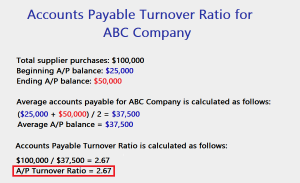

It calculates the time it takes a company to sell off all its inventory. Inventory Turnover Ratio = Net Sales / Inventory 5) Days Sale in InventoryĪnother inventory-related asset management ratio is the Days Sale in Inventory. A low ratio, on the other hand, may indicate slow-moving inventory. While a higher Inventory Turnover Ratio is preferable, it can also indicate a risk of stock outs if it is too high.
#Payable turnover ratio formula how to#
Related article How to Calculate Activity Ratios? It shows how many times the company has sold and restocked its inventory within the accounting period under consideration. Net Working Capital Turnover = Sales / Net working capital 4) Inventory Turnover RatioĪnother asset management ratio that is considered critical is the Inventory Turnover Ratio. The higher this ratio is for a company, the better it uses its working capital to generate revenues.

However, this ratio is usually a better indicator of a company’s operations than using total assets. It is also a type of asset turnover ratio. The Net Working Capital Turnover is a ratio that signifies the efficiency of a company in using its working capital. While it is a type of asset turnover ratio, some stakeholders prefer only to consider the company’s fixed assets to evaluate its efficiency.Īsset turnover = Sales / Fixed Assets 3) Net Working Capital Turnover This ratio only considers the use of long-term assets as compared to short-term. The Fixed Asset Turnover is a ratio that measures the efficiency of a company in the use of only its fixed assets to produce sales. The higher the company’s asset turnover ratio is, the better and more efficient it is considered by stakeholders.Īsset turnover = Sales / Total Assets 2) Fixed Asset Turnover It gives a summary of all the asset management turnover ratios. The Total Asset Turnover is a ratio that measures the efficiency of a company in the use of all its assets to produce sales. Some of the most commonly used asset management ratios are as below. Therefore, asset management ratios can help with all these aspects and much more.

Similarly, just because companies can make profits doesn’t mean they are using their assets effectively. However, judging companies by the amount of their profit is not suitable for comparisons. Usually, stakeholders prefer companies with higher profits. Usually, the better these ratios are, the higher the chances of investors and shareholders investing in the company.įurthermore, these ratios allow stakeholders to analyze the financial performance of a company from multiple aspects. Through these ratios, they can calculate the efficiency and effectiveness of their investments. Usually, asset management ratios are crucial for investors and shareholders.

The purpose of why stakeholders calculate asset management ratios depends on the type of stakeholder. Some of the most commonly used asset management ratios include inventory turnover, accounts payable turnover, days sales outstanding, days inventory outstanding, fixed asset turnover, receivable turnover ratios, and cash conversion cycle. Since companies have various types and classes of assets, there are also different ratios for different assets. As the name suggests, these ratios usually consider only two factors, a company’s assets and revenues. Through these ratios, the company’s stakeholders can determine the efficiency and effectiveness of the company’s assets management.ĭue to this, they are also called turnover or efficiency ratios. At the same time, the higher ratio may also imply lesser discount facilities availed or higher prices paid for the goods purchased on credit.Asset management ratios are a group of metrics that show how a company has used or managed its assets in generating revenues. In other words, higher the ratio, the company enjoys the credit period allowed by the suppliers and the amount may be used for some other productive purpose. Generally, lower the ratio, the liquidity of the business concern is in better position and vice versa. This ratio indicates the degree of efficiency of management in paying creditors amount. Significance of Average Payment Period Ratio of Working Days / Creditors Turnover Ratio of Working Days / Annual Net PurchasesĪverage payment period = No. of days or weeks or months in the periodĪverage payment period = Trade Creditors x No. Net Credit Purchase per day or per week or per month = Net Credit Purchase for the period / No. Percentage of Payable to Net Purchase = Payable / Net Purchases x 100Īverage Payment Period Ratio (or) Average Age of Payable = Average Trade Creditors / Net Credit Purchase per day or Per week or per month Percentage of Net Purchases to Payable = Net Purchases / Payable x 100


 0 kommentar(er)
0 kommentar(er)
